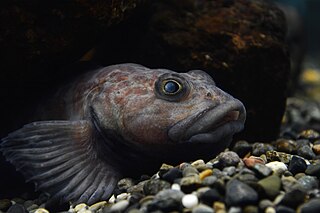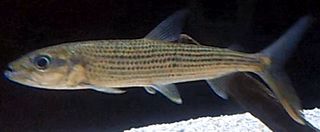
The Baikal seal, also known as Lake Baikal seal or Baikal nerpa, is a species of earless seal endemic to Lake Baikal in Siberia, Russia. Like the Caspian seal, it is related to the Arctic ringed seal. The Baikal seal is one of the smallest true seals and the only exclusively freshwater pinniped species. A subpopulation of inland harbour seals living in the Hudson Bay region of Quebec, Canada,, as well as the Saimaa ringed seal and the Ladoga seal, are also found in fresh water, but these seals are part of species that also have marine populations.

The Abyssocottinae are a subfamily of ray-finned fishes in the family Cottidae, the sculpins. They are known commonly as the deep-water sculpins. The entire subfamily is endemic to Lake Baikal in Siberia.

The tench or doctor fish is a fresh- and brackish-water fish of the order Cypriniformes found throughout Eurasia from Western Europe including Britain and Ireland east into Asia as far as the Ob and Yenisei Rivers. It is also found in Lake Baikal. It normally inhabits slow-moving freshwater habitats, particularly lakes and lowland rivers.

The Siberian sturgeon is a species of sturgeon in the family Acipenseridae. It is most present in all of the major Siberian river basins that drain northward into the Kara, Laptev and East Siberian Seas, including the Ob, Yenisei Lena, and Kolyma Rivers. It was also found in Kazakhstan and China in the Irtysh River, a major tributary of the Ob, though wild populations are extirpated in China. The species epithet honors the German Russian biologist Karl Ernst von Baer.
The Lake Baikal mountain vole or Olkhon mountain vole is a species of rodent in the family Cricetidae. It is found principally on the Olkhon and Ogoi islands on Lake Baikal, in southern Siberia. It is also found in a small part of the bordering mainland Russia, on the Baikal coast of the Irkutsk Oblast. It was originally described as a subspecies of the silver mountain vole. Since then, it has been synonymized with A. roylei in 1978, A. tuvinicus, and A. macrotis before reinstating it as a species. It is likely a sister species to A. tuvinicus.
Procottus is a genus of ray-finned fish belonging to the family Cottidae, the typical sculpins. These fishes are endemic to Lake Baikal in Russia.
Dmitrii Nikolaevich Taliev was a Soviet Russian ichthyologist and limnologist, notable for his work on the Lake Baikal.
The Gilbert's garden eel, also known as the Gilbert's conger and the sharpnose conger, is an eel in the family Congridae. It was described by James Douglas Ogilby in 1898, originally under the genus Congrellus. It is a tropical, marine eel which is known from the eastern central and southeastern Pacific Ocean, including the Gulf of California, Costa Rica, El Salvador, Ecuador, Guatemala, Mexico, Honduras, Nicaragua, Panama, and Colombia. It is a benthic and nocturnal species, and inhabits sand flats in reefs, bays and coves at a depth range of 1–100 metres. It burrows into sand during the day and emerges to forage during the night. Males can reach a maximum total length of 27 centimetres.
Heteroconger chapmani is an eel in the family Congridae. It was described by Albert William Herre in 1923. It is a marine, tropical eel which is known from a single specimen collected from the Philippines, in the western central Pacific Ocean. The holotype specimen measured 69 cm. The species is now considered unidentifiable due to the lack of detail in the author's description, and because the only known specimen was destroyed during World War II.

Cynoponticus savanna,, the Guayana pike-conger, pike-headed eel or sapphire eel, is an eel in the family Muraenesocidae. It was described by Edward Nathaniel Bancroft in 1831, originally under the genus Conger. It is a marine, tropical eel which is known from the western Atlantic Ocean, including Central America, the Caribbean and Brazil. It dwells at a maximum depth of 100 metres (330 ft), and inhabits muddy substrates in bays and estuaries. Males can reach a maximum total length of 150 centimetres (59 in), but more commonly reach a TL of 50 centimetres (20 in).
The snaggle-toothed snake-eel is an eel in the family Ophichthidae. It was described by John E. McCosker and David Ross Robertson in 2001. It is a marine, tropical eel which is known from a single specimen collected from Panama, in the eastern central Pacific Ocean. From the specimen it is known to dwell at a depth range of 5–10 metres, and reach a maximum total length of 104 centimetres. Based on other eel species it is estimated to inhabit burrows on a permanent or semi-permanent basis, and feed on small fish and crustaceans.
The Ordinary eel is an eel in the family Ophichthidae. It was described by Richard Heinrich Rosenblatt and John E. McCosker. It is a marine, subtropical eel which is known from a single specimen collected from a sandbank in the Gulf of California, in the eastern central Pacific Ocean, during low tide. From the holotype, it is known to reach a total length of 51 centimetres (20 in).
The thin snake eel is an eel in the family Ophichthidae. It was described by John E. McCosker and Richard Heinrich Rosenblatt in 1998. It is a marine, tropical eel known from the eastern central and southeastern Pacific Ocean, including Mexico and Colombia. It is known from two specimens observed dwelling in sand at a depth range of 0 to 8 m. The maximum length recorded was 23.1 cm (9.1 in), albeit on an immature specimen.

Abyssocottus gibbosus is a species of ray-finned fish belonging to the family Cottidae, the typical sculpins. These sculpins are endemic to Lake Baikal in Russia. It dwells at a depth range of 400–1600 metres. Males can reach a maximum total length of 14 centimetres.
Asprocottus intermedius is a species of ray-finned fish belonging to the family Cottidae, the typical sculpins. It was described by Dmitrii Nikolaevich Taliev in 1955, originally as a subspecies of Asprocottus herzensteini. It is a freshwater fish which is endemic to Lake Baikal, Russia. It is known to dwell at a depth range of 200–800 metres.
Asprocottus minor is a species of ray-finned fish belonging to the family Cottidae, the typical sculpins. It was described by Valentina Grigorievna Sideleva in 2001, originally as a subspecies of Asprocottus korjakovi. It is a freshwater fish which is endemic to Lake Baikal, Russia.
Procottus jeittelesii, the red sculpin or red Baikal sculpin, is a species of ray-finned fish belonging to the family Cottidae, the typical sculpins. This species is endemic to Lake Baikal in Russia. It is a freshwater fish that dwells under stones or in holes in the mud at a depth range of 0 to 800 m. It is often found at around 100 m (330 ft), and is most abundant during the autumn and winter. From the late winter to the spring it breeds at depths of 5 to 30 m. It can reach a maximum length of 18 cm (7.1 in), but typically is 10–12 cm (3.9–4.7 in). It has a red spotted or banded pattern on a light background. The red sculpin resembles two of its close relatives, the smaller P. gurwici and the larger P. major.

Hydrocynus forskahlii, the elongate tigerfish, is a species of predatory characin from the family Alestidae which is found in northern and western Africa.
The flapnose sea catfish, also known as the brown sea catfish, is a species of catfish in the family Ariidae. It was described by Theodore Gill in 1863, originally under the genus Leptarius. It inhabits rivers and estuaries in Ecuador, Colombia, Guatemala, Costa Rica, El Salvador, Panama, Honduras, Nicaragua, Mexico, and Peru. It dwells at a depth range of 0 to 15 m. It reaches a maximum total length of 90 cm (35 in), more commonly reaching a TL of 50 cm (20 in).
Thymallus nigrescens, also known as the Hovsgol grayling, is a species of freshwater fish in the salmon family. It is endemic to the Mongolian Lake Khovsgol where they usually live near or on the bottom of the lake.







